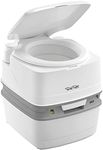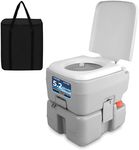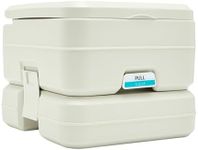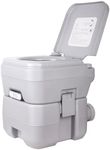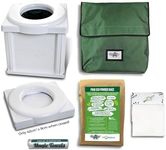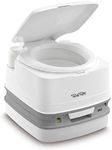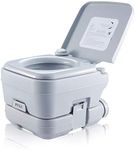Buying Guide for the Best Portable Toilets
Choosing the right portable toilet involves considering several factors to ensure it meets your needs. Whether you're planning a camping trip, hosting an outdoor event, or need a temporary solution for a construction site, understanding the key specifications will help you make an informed decision. Here are the main aspects to consider when selecting a portable toilet.CapacityCapacity refers to the amount of waste a portable toilet can hold before it needs to be emptied. This is important because it determines how often you will need to service the toilet. Smaller capacities (around 5-10 gallons) are suitable for short trips or small groups, while larger capacities (15-20 gallons or more) are better for extended use or larger groups. Consider the number of users and the duration of use to choose the right capacity for your needs.
PortabilityPortability is about how easy it is to transport and set up the toilet. This includes the weight, size, and whether it has features like carrying handles or wheels. Lightweight and compact models are ideal for camping or situations where you need to move the toilet frequently. Heavier models with more features might be better for stationary use at events or construction sites. Think about how often you'll need to move the toilet and choose one that balances portability with your other needs.
Flushing MechanismThe flushing mechanism determines how waste is managed and how clean the toilet stays. Basic models may have a simple gravity flush, while more advanced ones might use a pump or battery-operated flush. A more efficient flushing system can help reduce odors and keep the toilet cleaner. If cleanliness and ease of use are priorities, consider a model with a more advanced flushing mechanism. For simpler needs, a basic flush might suffice.
Waste DisposalWaste disposal refers to how easy it is to empty and clean the toilet. Some models have detachable tanks that can be easily removed and emptied, while others might require more effort. Look for features like spout designs that minimize splashing and make the process more hygienic. If you plan to use the toilet frequently, ease of waste disposal will be a significant factor. Choose a model that makes this process as simple and clean as possible.
ComfortComfort includes the size of the seat, the height of the toilet, and any additional features like armrests or a lid. A more comfortable toilet can make a big difference, especially for extended use. Taller models are generally easier to use for adults, while smaller ones might be better for children. Consider who will be using the toilet and for how long to determine the level of comfort you need.
DurabilityDurability is about how well the toilet can withstand regular use and various environmental conditions. Look for materials like high-density polyethylene, which is strong and resistant to damage. If you need a toilet for rugged outdoor use or long-term projects, durability will be crucial. Choose a model that is built to last and can handle the wear and tear of your specific use case.
Odor ControlOdor control features help keep unpleasant smells at bay. This can include ventilation systems, seals, and the use of chemicals. Effective odor control is essential for user comfort and hygiene. If the toilet will be used in close quarters or for extended periods, prioritize models with good odor control features. For short-term or outdoor use, this might be less critical.
